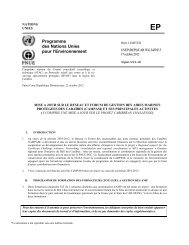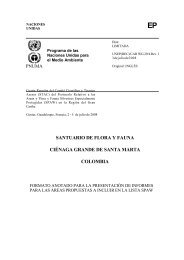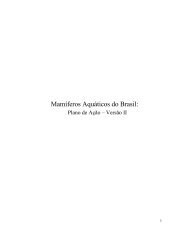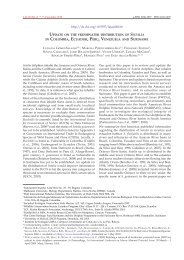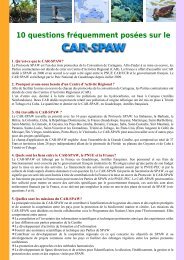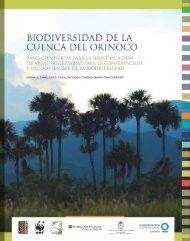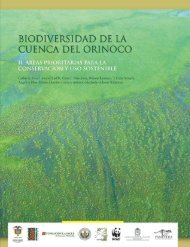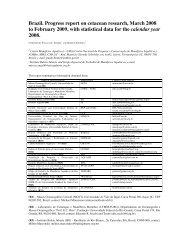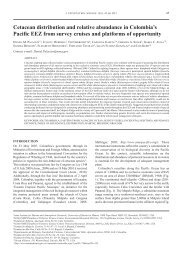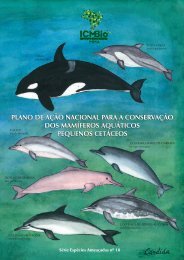Interaction between killer whales (Orcinus orca ... - Mar de Cetáceos
Interaction between killer whales (Orcinus orca ... - Mar de Cetáceos
Interaction between killer whales (Orcinus orca ... - Mar de Cetáceos
You also want an ePaper? Increase the reach of your titles
YUMPU automatically turns print PDFs into web optimized ePapers that Google loves.
JMBA2 - Biodiversity RecordsPublished on-line<strong>Interaction</strong> <strong>between</strong> <strong>killer</strong> <strong>whales</strong> (<strong>Orcinus</strong> <strong>orca</strong>) and a leatherbackturtle (Dermochelys coriacea) off the north-eastern coast of VenezuelaLenin Oviedo* †∫ , <strong>Mar</strong>ía Alejandra Esteves*, Estefanía Alfe*, Romina Acevedo † & Jaime Bolaños-Jiménez ‡*Proyecto Delphinus, Isla <strong>de</strong> <strong>Mar</strong>garita, Venezuela. † Proyecto Golfo <strong>de</strong> la Ballena, Biotrópica, Caracas, Venezuela. ‡ Sociedad Ecológica VenezolanaVida <strong>Mar</strong>ina (Sea Vida), A.P. 162, Cagua, Estado Aragua, Venezuela 2122. ∫ Corresponding author, e-mail: biotropica2@yahoo.comThe presence of <strong>Orcinus</strong> <strong>orca</strong> in Venezuelan waters has remained somehow unclear. On 15 April2007 a group of three <strong>killer</strong> <strong>whales</strong> was recor<strong>de</strong>d on vi<strong>de</strong>o interacting with a leatherback turtleoff north-eastern Venezuela. This report is based on an extensive review of the original vi<strong>de</strong>o takenduring the sighting event and a <strong>de</strong>tailed interview with the observers. This record of <strong>killer</strong> <strong>whales</strong>interacting with Dermochelys coriacea, as well as opportunistic sightings recor<strong>de</strong>d in photographs<strong>between</strong> 2001–2008, represent the most solid confirmation of the species occurrence in Venezuelanterritorial waters.Keywords: Killer whale, leatherback turtle, sighting, interaction, vi<strong>de</strong>o, north-eastern coast of Venezuela.The first record of <strong>killer</strong> <strong>whales</strong> in Venezuela was reported in 1979 from a stran<strong>de</strong>d individual atthe mouth of the <strong>Mar</strong>acaibo Lake, west coast of Venezuela (Rodriguez et al., 1993). Subsequently,there have been several anecdotal accounts, and even sightings of occasional individuals on publishedreviews on the cetacean fauna in territorial waters (Bolaños & Boher, 1996; Acevedo, 2001; Romeroet al., 2001; Acevedo, 2007) and a review of occasional sightings recor<strong>de</strong>d by non-professionalobservers (Bolaños-Jiménez et al., 2008). Nevertheless,even within those published records, a major proportionof them lack of visual evi<strong>de</strong>nce such as clear pictures orvi<strong>de</strong>o recordings. Therefore, the presence of <strong>Orcinus</strong> <strong>orca</strong>in Venezuelan waters has remained somehow unclear.On 15 April 2007, a group of three <strong>killer</strong> <strong>whales</strong> (<strong>Orcinus</strong><strong>orca</strong>) was vi<strong>de</strong>o-recor<strong>de</strong>d interacting with a leatherbackturtle (Dermochelys coriacea). The observers, a family groupon a recreational fishing trip, ma<strong>de</strong> the vi<strong>de</strong>o wi<strong>de</strong>spreadby uploading some portions of it to a mass media websiteon the Internet (http://www.youtube.com). This report isbased on an extensive review of the original vi<strong>de</strong>o takenduring the sighting event and a <strong>de</strong>tailed interview with theobservers. The <strong>whales</strong> were first sighted at approximately14:00 h. The group was composed by one adult maleand either two adult females (judging by notable sizedifferences according to the account of the observers),or an adult female and a sub-adult of unknown sex. The<strong>whales</strong> were located 10 nautical miles north-west of IslaBorracha (Mochima National Park), off north-easternVenezuela (Figures 1 and 2). The smaller <strong>whales</strong> wereengaged in a high level of interaction with the turtle whilethe male remained surfacing at a distance of about 500 mfrom the boat. One of them initiated the interaction at alltimes, in what seemed to be an attempt to encourage theother whale to participate in the interaction event. The<strong>killer</strong> <strong>whales</strong> appeared to harass the turtle by continuouslyswimming alongsi<strong>de</strong> it in circles and turning the turtleupsi<strong>de</strong> down by creating turbulence, making escape by theturtle difficult. The interaction lasted for at least 30 minfrom the time of first sighting; the <strong>whales</strong> appeared to beundisturbed by the presence of the boat. The interactionen<strong>de</strong>d with the dragging of the turtle by one of the <strong>whales</strong>to a <strong>de</strong>pth of approximately 100 m (recor<strong>de</strong>d by the fishfin<strong>de</strong>rof the boat), closely followed by the juvenile (seeFigure 1. Killer <strong>whales</strong> asi<strong>de</strong> the leisure boat. Photograph taken by the Alcarafamily, on 15 April 2007, 10 miles off Isla Borracha, north-east coast of Venezuela.Figure 2. Killer <strong>whales</strong> sightings (15 April and 5 May 2007) location (solid lineellipse) off Isla Borracha, Mochima National Park, north-east coast of Venezuela.
L. Oviedo et al. Killer <strong>whales</strong> off the coast of north-eastern Venezuelaalso Bolaños-Jiménez et al., 2008). After the <strong>whales</strong> dove with the turtle, they were not re-sighted. Ofadditional interest is that over two weeks later (5 May), another group of <strong>killer</strong> <strong>whales</strong> was sightedin the same location, possibly the same group, since it was also composed of three individuals (amature male a female and juvenile). Photographic evi<strong>de</strong>nce supports these observations; however,they were not of sufficient quality for photo-i<strong>de</strong>ntification purposes.Fertl & Fulling (2007) reported several cases of <strong>killer</strong> <strong>whales</strong> preying on sea turtles. Of particularinterest is that reported by Caldwell & Caldwell (1969) of three <strong>whales</strong> killed from a group of sixby a commercial fishing boat in the Caribbean Island of St Vincent, all with remains of leatherbackturtle in their stomachs. According with the information from the interview with the observers, andthe analysis of the vi<strong>de</strong>o, this episo<strong>de</strong> would not entirely represent a predatory event, in terms ofprey consumption as <strong>de</strong>scribed in some others reports (Sarti et al., 1994; Pitman & Dutton 2004),even though the <strong>whales</strong> disappeared with the turtle. As mentioned before, the latter interactionseemed to be an opportunistic play in the context of prey capture, possibly led by an adult towardsa sub-adult.Little directed research on <strong>killer</strong> <strong>whales</strong> in the tropics is closely related with the low <strong>de</strong>nsity ofthe species in lower latitu<strong>de</strong> areas (Baird et al., 2006). For instance, Baird et al. (2006) consi<strong>de</strong>r <strong>killer</strong><strong>whales</strong> to be rare around the Hawaiian Islands, based on the ease of recognizing this species, thenumber of potential observers on the water (including researchers on vessel and aerial platforms,as well as commercial whale and dolphin watching companies and sport-fishing charter operators),and the fact that many of these records are of sufficient public interest to make it into the media(such as the case of this contribution). In a recent review of occasional sightings recor<strong>de</strong>d aboardleisure boats in northeastern and central Venezuela <strong>between</strong> 2001–2008, Bolaños-Jiménez et al.(2008) hypothesised about the possible relation of the presence of <strong>killer</strong> <strong>whales</strong> with cold waterincursions and even with the presence of billfish, tunas and whale-sharks, but this remains to beinvestigated. This record of <strong>killer</strong> <strong>whales</strong> interacting and possibly preying on D. coriacea is highlyrelevant in terms of confirming the species presence in the region and for the potential implicationsof <strong>killer</strong> <strong>whales</strong> in the trophic dynamic of the north-eastern coast of Venezuela. Therefore, continuityin research effort directed to the non common species should be consi<strong>de</strong>red.The authors would like to especially thank the Alcaras family: Miguel Alcaras, Estefy and Gabriela Alcaras. Theyhave ma<strong>de</strong> a crucial contribution to the study of <strong>whales</strong> and dolphins in Venezuela by sharing the informationthey collected. Robin Baird, Dagmar Fertl, Miguel Iñíguez and Robert Pitman provi<strong>de</strong>d us with useful insightsto improve the manuscript.REFERENCESAcevedo Galindo, R., 2001. Distribución y caracterización <strong>de</strong> hábitat <strong>de</strong> cetáceos marinos en Venezuela. ThesisDissertation, Universidad Central <strong>de</strong> Venezuela, Caracas, 243 pp.Acevedo Galindo, R., 2007. Potencial distribution of seven species of marine cetaceans reported in Venezuela,Southeast Caribbean. Acta Zoologica Sinica, 58, 853–864.Baird, R., McSweeney, D.J., Bane, C., Barlow, J. ,Sal<strong>de</strong>n D. R., Antoine, L. K., LeDuc, R. G.,& Webster, D.L., 2006.Killer <strong>whales</strong> in Hawaiian waters: information on population i<strong>de</strong>ntity and feeding habits. Pacific Science, 60,523–530.Bolaños, J. & Boher, S., 1996. Lista actualizadas <strong>de</strong> cetáceos <strong>de</strong> Venezuela. Natura, 106, 51–53.Bolaños-Jiménez, J., Fertl, D. & Iñíguez. 2008. Killer whale (<strong>Orcinus</strong> <strong>orca</strong>) occurrence in Venezuelan waters, 2001–2008. Paper IWC/60/SC/SM8 presented to the International Whaling Commission, Santiago <strong>de</strong> Chile, June2008.Caldwell, D.K. & Caldwell, M.C., 1969. Addition of the leatherback sea turtle to the known prey of the <strong>killer</strong>whale, <strong>Orcinus</strong> <strong>orca</strong>. Journal of Mammalogy, 50, 636.Fertl, D. & Fulling G.L., 2007. <strong>Interaction</strong> <strong>between</strong> marine mammals and turtles. <strong>Mar</strong>ine Turtle Newsletter, 115,4–8.Pitman, R.L. & Dutton P.H., 2004. Killer whale predation on a leatherback turtle in the Northeast Pacific. PacificScience, 58, 497–498.Rodríguez, E., Acosta, R., Pérez, C., Urdaneta, T., Parada, M., Cabezas, E., Fuenmayor, S., Arrieche, D., Gómez, L.,Bong, J., Viloria, A. & Duarte, M., 1993. <strong>Orcinus</strong> <strong>orca</strong> (Linnaeus), 1758 (Cetacea: Delphinidae) en la costa norte<strong>de</strong>l estado Zulia, Venezuela. Anartia, 4,1–8.Romero, A., Agudo, A.I., Green, S.M. & Nobartolo di Sciara, G., 2001. Cetaceans of Venezuela: their distributionand conservation status. US Department of Commerce, NOAA Technical Report, NMFS 151, 60 pp.Sarti, M.L., Flores, O.L. & Aguayo, L.A., 1994. Evi<strong>de</strong>nce of predation of <strong>killer</strong> whale (<strong>Orcinus</strong> <strong>orca</strong>) on a leatherbacksea turtle (Dermochelys coriacea) in Michoacan, Mexico. Revista <strong>de</strong> Investigación Científica <strong>de</strong> la UniversidadAutonoma <strong>de</strong> Baja California Sur, 2, 23–26.Submitted 12 January 2008. Accepted 29 July 2008.JMBA2 - Biodiversity RecordsPublished on-line



